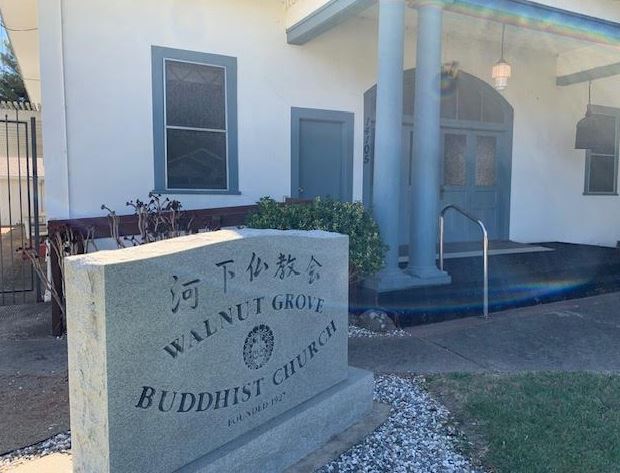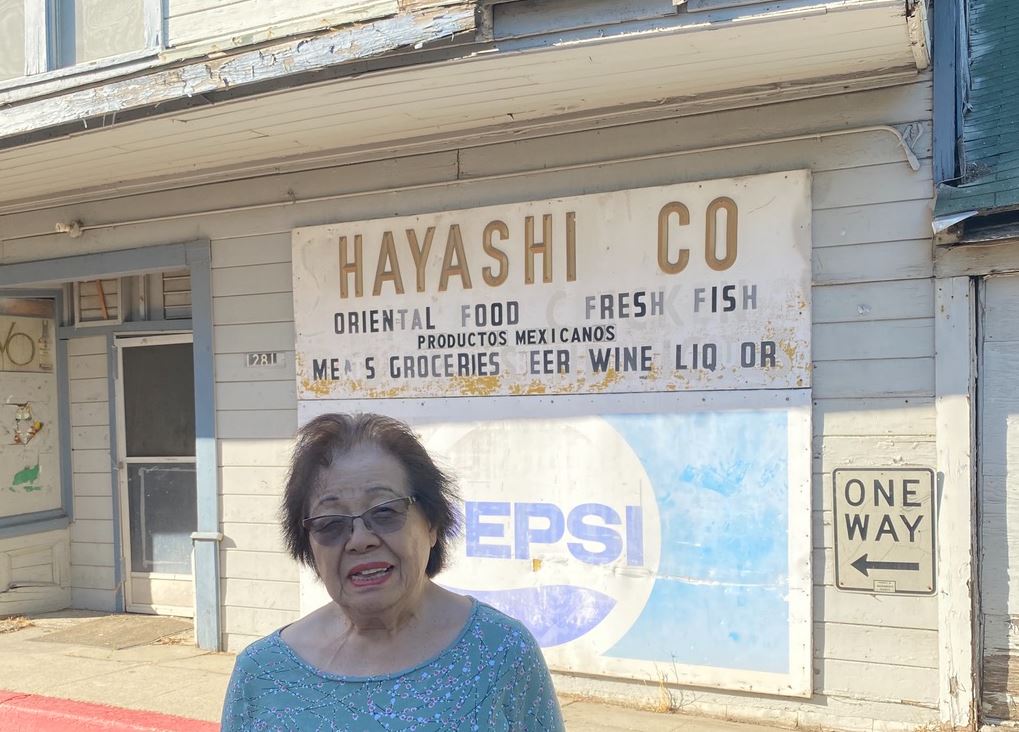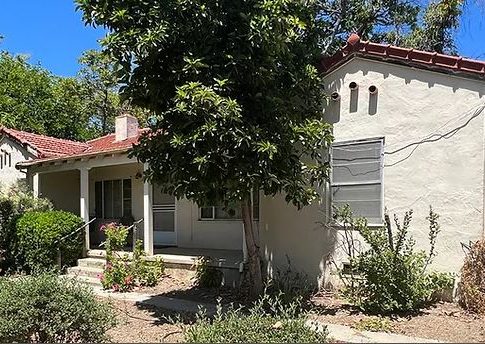By David Hosley
Unique Japanese American Architecture Preserved In Tiny Delta Town
At midday on October 7, 1915, a fire started in downtown Walnut Grove. Attempts to put it out failed and winds coming off the river spread it through homes and businesses of the Chinese residents and also burned part of the smaller Japanese section. Yasu Kawamura, Walnut Grove’s first picture bride in 1912, gave her eyewitness account through an interpreter in 1980:
“It started about noon…when all the people was cooking for their lunch. All the houses burned down in two hours’ time. She said this person, newly arrived from Japan, tried to start a fire and the whole building was papered with newspapers, and that started the whole fire. The house that caught on fire was on the river side of the levee on stilts. It caught fire but it jumped the levee and it caught all the houses on the east side. It wasn’t windy, but the fire drew the wind.
“The men fought the fire. The houses were left to the women. Most had no time to save more than themselves and their children and maybe some clothing. The families went to the Japanese school house. The empty lots were a fire break and the school was protected from the fire.”
LATEST STORIES
Two fire boats were put into the firefight. A number of deputies from the Sacramento County Sheriff’s Office responded. Fortunately, a change in wind direction reversed the blaze’s path. By 5 p.m. the fire lines held although spot fires existed into the night. Ashes from the blaze were said to have landed in Woodbridge, 15 miles to the southeast.
No one was killed, but the downtown was destroyed. More than 80 buildings were torched, including the majority in the Chinese section. Several dozen Japanese also lost their homes and businesses, but the flames stopped at C Street, which was an unofficial separation of the two Asian enclaves. A Sacramento newspaper reported “The hotel, store, bridge and the residences of the Americans are standing unhurt.” Another paper in the Capitol had a follow up story the next day which forecast “Modern buildings will replace 856 structures consumed in flames.” But that’s not exactly what happened.
To understand the surprising response to the fire, it’s important to know how Walnut Grove came to be, and the dynamics between the Chinese, Japanese and Caucasian landowners who lived there before the fire.
Chinese Pioneers From Pearl River Basin
Chinese immigrants came to Walnut Grove, along the Sacramento River, as early as the 1860’s. The town had been founded in 1851 and became an important port between Sacramento and San Francisco Bay. Agriculture blossomed, especially pear orchards, and farm hands were needed. The Chinese were also a critical labor force as levees were built in the 1870’s and 80’s, creating a vast addition to the Central Valley’s rich farmland.
Despite the Chinese Exclusion Act of 1882, which restricted immigration and also forbid naturalization of those already living in the United States, Chinese workers helped farms prosper in the Delta and a number settled in Walnut Grove. They fostered a Chinatown, most of them coming from agricultural areas on either side of the Pearl River in southern China. Their neighborhood boasted restaurants, grocery stores, bath houses and herb stores. Saloons, gambling establishments and houses of prostitution also dotted the area, the latter a predictable result of almost all of the farm workers being young single men.
With the increased restriction on Chinese immigrants, Japan emerged as the provider of Delta field workers with the skills to nature a growing list of crops that included other fruit trees, tomatoes, asparagus, onions and celery. The first-generation Nisei came largely from the south of Japan, which although opening up to emigration, was also experiencing a depression. Labor bosses in California started recruiting across the Pacific, attracting not only Japanese but also Filipinos males to the Delta. From 1860 to 1880, historian Wayne Maeda reports, 446 Japanese came to the United States. Some 200 passports had been issued in that time to Japanese identifying as craftsmen or laborers.
Setting Up Shop
The first known Japanese business in Walnut Grove was a noodle shop, started in 1896. By 1900, according to the U.S. census there were more than 10,000 Japanese living in California, and Walnut Grove’s growing Nisei population reflected that although Chinese, mostly from Chengshan and Sze Yup, outnumbered them.
The Japanese hub at the northern part of Walnut Grove’s Chinatown drew farm workers in from surrounding communities for social and sporting events as well as religious services. Until the so-called Gentlemen’s Agreement in 1908, almost all of the first-generation Japanese immigrants had been young single men.
But that pact, stemming from a lawsuit over integration of a school in San Francisco, had resulted in throttling down the flow of laborers but increasing the number of Nisei women markedly. Some bachelors returned to Japan to find a spouse, others exchanged photos and met their brides coming off ships in San Francisco and Seattle.
The Asians in Walnut Grove were not the owners of the property downtown, for the most part, nor many of the buildings. This inability to own acreage was formalized in 1913 when the California legislature passed the Alien Land Law, preventing all foreign-born aliens from owning land.
Almost all of the downtown lots in Walnut Grove were owned by two families: the Dye brothers who held much of the Chinatown deeds, and Alex Brown who had several other enterprises including a hotel and grocery store, but also the Bank of Alex Brown, which his son operated. A directory of Japanese businesses in 1914 listed 67 Nisei owned enterprises, the majority of them paying monthly rent. On weekends, Walnut Grove would draw visitors from Thornton, Grand Island, Courtland, Clarksburg, Isleton, Lodi and even Sacramento.

Heading Up The Levee
The day after Walnut Grove’s 1915 fire disaster, a group of Chinese picked up and left, walking the mile up the river road to Lockport, a much smaller town than Walnut Grove that had a mix of residents, including several Chinese families who built a store, saloon and hotel in 1912. Lockeport featured a packing shed next to the Sacramento River and was surrounded by pear orchards and other fields. A new cannery had been built earlier in 1915, and a boarding house and other buildings were on hand for those who worked in and provided services for the town’s enterprises.
The Chinese families were from Zhongshan in southern China, and had shared Walnut Grove’s Chinatown, sometimes uneasily, with immigrants from Sze Yup on the western side of the Pearl River. Farmer George Locke agreed to rent land to them and other refugees from the fire, tearing down pear orchards to make additional lots available, and helping to construct new buildings. Not quite overnight, Lockeport (later to be known as Locke) became a much bigger, and much more Asian, town which included some Japanese families from Walnut Grove among immigrant Filipinos, Portuguese, Germans, Mexicans and others.
Downriver, Walnut Grove began a boom time in a surprising way. The Sze Yup immigrant families, most of whom spoke the Toishanese dialect, replaced buildings on some of the Chinatown blocks that had burned. Others hesitated, complaining the Dyes wanted exorbitant rents for their lots.
The Japanese residents expanded north from their existing node and rented land from Alex Brown. They did so by bringing in expertise from the northern California Japanese community, including Nisei architects and craftsmen from as far away as San Francisco and Central California. For their planned structures, families entered a lottery to seek a preferred location. Brown paid for improved water delivery and sewage disposal and built a number of new commercial spaces that he rented out to Japanese.

The result was striking. Buildings were soon rising with iconic Nipponese characteristics. Mostly two stories, they were made of wood with balconies and featuring curved and sometimes tiled roofs. The ground floors were usually occupied by businesses, with families living above. A number of buildings boarded single men or were operated by small businesses that served food or provided entertainment.
As the region’s growers prospered during World War I the ranks of farm workers grew, tapping the services in the town, which they called Kawashima, meaning “downriver.” A new Japanese Methodist Church was founded in 1915, the only one in the Sacramento region. Hundreds of newly paid laborers would come to Walnut Grove’s Japanese neighborhood (Nihonmachi) on weekends.
A drawbridge would be built in 1915, as well, spanning the Sacramento River and leading from the downtown to homes owned by White families. Very rarely would a non-white live on the west side of Walnut Grove, which would have its own church and segregated school.
Exclusion Acts and Segregation Of Education
In 1912, the California legislature adopted the Alien Land Law, primarily aimed at restricting ownership of land by Japanese immigrants, but also applying to other Asian American communities. The state body tightened restrictions in 1920 and again in 1923. California laws were copied, in whole or in part, in other states in the west but as far away as Florida. In 1923 the U.S. Supreme Court reviewed these laws and upheld every one of them.
In response to the latest anti-Asian measures, the Nisei in Walnut Grove began to collect money to build a Japanese language school. The purpose of the school was grim. It would ensure that their children would be able to speak the language and be able to navigate the culture if their families were forced to return to Japan. By 1927, 300 donors had contributed enough to hire a Japanese architect from San Francisco who ironically designed a classic Mission Revival school house. When it was built, three full time teachers were hired.

The local Japanese immigrants in the 1920’s also felt a need for a Buddhist Church. Tome Yoshida first hosted a Sunday School in her home, and a Buddhist Church was built in 1927. By 1931 it had more than a hundred members. The Japantown expanded further, creating an area called Backtown, which had bigger lots and a hotel and auto garage. Even during the Depression, Walnut Grove’s Japanese community supported a movie theater, boarding house, bathhouses, medical professionals and the two places of worship, which also were meeting places for a number of civic organizations.
Anti-Asian discrimination included local education, and in 1921 the Walnut Grove school was formally segregated. There had been exclusion in practice before making it official. Students who attended the Oriental School in the 1930’s recall they got worn textbooks with out-of-date maps and information, and their physical education equipment had to be repaired to be used. A new grammar school on the east side of the railroad tracks was built with federal funds in 1936, and it was also segregated. Only in 1943, after the Japanese students had been removed, segregation was ended which impacted the remaining Filipino and Chinese students.
Memories of Life On The River
Sam Kuramoto went to school in Walnut Grove in the late 1930’s. His parents Sekeichi and Nobu had come to the Delta from Yamaguchi Prefecture south of Hiroshima in 1914, and bought the Locke Boarding House, which they called Sam’s Rooms, in 1921. The youngest of five children, Sam shared his memories in an oral history. His parents had an initial goal, he recalled. “They wanted to make money and go back to Japan.”
Sam was born in 1928, and his parents would augment income from the boarding house by working in the fields near Lodi, Watsonville and around Walnut Grove. They picked Tokay grapes, strawberries, asparagus, and tomatoes, the latter both for the table and for pickling. During harvest season, Nobu worked in a packing shed that was just across the road from the boarding house. His family lived downstairs and the upstairs rooms were rented. They called the south side of their building the “China” side, as that’s where the evacuees from Walnut Grove had settled a decade before.
The Kuramoto’s tended to stay away from that part of town, which had a lot of gambling and prostitution, except to shop in a Chinese store located next door to them.
His mother would walk to Walnut Grove often to shop at the Japanese stores, and when Sam started school he went to the segregated Oriental grammar school in Walnut Grove. It was a mile and River Road was the only way on foot to go over the Delta Cross Channel. He remembers it was a one room school for first to eighth grades with Filipino, Chinese and Japanese American students. If you were part-Asian, then you also attended the Oriental school which was on the Chinese side of town.
He recalls his teacher was Mrs. Pryor. “Boy, was she strict.” If Mrs. Pryor was unhappy with a student’s performance, she would command “Stick out your hands” and deliver a whack with a ruler. During recess, the boys played football, baseball and basketball. Grammar school got out at 3 o’clock, but that didn’t mean the end of education.
Japanese classes for most Japanese American children started at 4 p.m. in a separate building in Walnut Grove, and parents paid tuition for a curriculum that primarily focused on language, geography and history. Taught in the rote style of Japan, it lasted until 6 p.m. on weekdays. In his break between classes, Sam hung out with his friends the Yagi brothers and the Kuramura brothers. Some days they’d try to catch catfish. On weekends, he might sometimes go to the movies in Walnut Grove. He particularly relished seeing Snow White and the Seven Dwarfs in 1937.
When he finally got home, it was usually one of his older sisters who fed him. During summers when he got old enough to work, Sam would join his mother packing pears. Other times she left him in charge of the boarding house, showing patrons to their spartan rooms upstairs, and taking their money. Mostly they were single men, but he remembers one White couple that spent part of the night and then absconded with the mattress, pillows and sheets before dawn.
Every few months the Kuramotos went to Sacramento, usually in their Star Car, stopping at Weinstock’s and a five and dime store on K Street. Once, Sam remembers, they ventured as far away as Yosemite. His mother made their clothes. Her advice to her youngest child was “You’re an American. Be proud to be American.”
By 1940, the Japanese section of Walnut Grove had grown much larger than the Chinese area, which had been diminished by a fire in 1937. Nihonmachi now stretched more than five blocks in the northern part of town. A good deal of the growth occurred in the so-called “Backtown” area east of the Southern Pacific stub line, featuring larger blocks and homes with yards and outbuildings.
Pearl Harbor And Executive Order 9066
Sam Kuramoto was eating breakfast with his brother, one of his sisters and his mother on the morning of December 7, 1941. It wasn’t usual, but his brother turned on the radio and they heard the devastating bulletins. “Wow, what will happen to us?” Nobu asked her children. The FBI came to their home after Pearl Harbor, looking for a relative who belonged to Nippon Jin Kai, a Japanese ancestral society. His uncle was arrested, as were a number of Japanese community leaders in western states.
When Executive Order 9066 was issued two and half months later, the Kuramoto family learned their fate from a poster nailed to a phone pole just a few feet from where they lived. Nobu ordered her children to burn everything in the boarding house that was Japanese. Sam lit a fire in the bathtub out back to carry out her wishes.
Residents forced from the area first gathered in Walnut Grove, were removed to assembly centers in Turlock and Merced in springtime and then incarcerated a few months later in concentration camps in Colorado and Arizona. Some other farm families from outside Walnut Grove were assembled in Walerga, just north of Sacramento, and then taken by train to the Tule Lake Relocation Center in far Northern California.
Walnut Grove’s Japantown was decimated by the government’s hasty evacuation. The churches were boarded up, and after a while, other neighborhood buildings were occupied by Philippine and Mexican workers, some of whom helped bring in crops Japanese laborers had planted.
In a strange turn, volunteers were sought in the concentration camps in the fall of 1942 to harvest crops ripening fields as far as several states away. There was a farm labor shortage in middle America due to enlistments as the U.S. military ramped up its personnel.
Starting in 1943, some internees were able to leave for educational opportunities away from the Pacific states, or jobs in the defense industry or other work deemed essential to the war effort. That spring, the U.S. Army called for volunteers to join an all Japanese American (except for the officers, who were Caucasian) combat unit. Twelve thousand responded, with a quarter of that number selected for basic training. Later, a smaller group went into the Military Intelligence Service, training to be interpreters and support for the Army in the Pacific Theater. Some of them used their linguistic skills as America occupied Japan after the 1945 surrender.
Scattered around the U.S., and to a lesser extent around the world, a portion of those relocated in 1942 decided to seek their futures away from the places they grew up. They felt there was a better future elsewhere. Others pined for home, despite an uncertain fate awaiting them in California where racial hatred still seethed.
Release And Dislocation
Japanese American families began returning to Walnut Grove in the summer of 1945. The Methodist Church minister and other volunteers helped the first returnees get settled, and the church was converted to a dormitory. A group held at Gila River returned in August, and one from Amache in September. At the end of 1945, a memorial service was held in Walnut Grove to honor those who had died while incarcerated.
Oral histories indicate a good number of those who lived in Walnut Grove before World War II returned in 1945 or early 1946. Mas Ito, one of the last back in May of 1946, came with his bride and small baby. “It was a relief to be back,” Ito related in a 1980 oral history. The couple had met while incarcerated and married in Tule Lake in 1944. When released the trio went to Walerga, the one-time assembly center north of Sacramento that became a temporary home for hundreds while they searched for jobs and a place to live. Ito estimates only 30 to 35 per cent returned to their Delta town. “People that was living here in Walnut Grove moved to Colorado and other parts.”
He joined the Young Men’s Association in Walnut Grove, mostly so he could play on their baseball team. Walnut Grove’s opponents included squads from Lodi, Isleton, Stockton, Courtland and Plymouth, up in the foothills. His family also belonged to the Buddhist Church, and he looked forward to the annual celebration of Buddha’s birth and festivals such as Obon Odori, which honors one’s ancestors.

Some even came who hadn’t lived in Walnut Grove before. Alyce Nakao had been born in Newcastle in the Sierra foothills. Her father Hatsunobu supported his family as a crew boss, and soon moved his young family to the Marysville area, whose Japanese community was interned at Tule Lake. Hatsunobu Nakao became a leader at Tule Lake, representing his ward during an investigation into the fatal shooting by a sentry of an unarmed detainee in 1944. Alyce completed 7th and 8th grade while incarcerated.
Tule Lake was the last concentration camp to be closed. The Nakao family and their relatives, including her uncle Isao “Pedro” Hamada, had time to talk over plans for their future. Pedro and his spouse Toshiko had roots in the Delta. Pedro’s father invited the Nakao’s to live in the back of a pool hall he operated on C Street in Walnut Grove. In the fall of 1946, Alyce started high school in Courtland, taking the bus eight miles each way.
She recalled to AsAmNews going to Ben’s Drug Store on Market Street, founded in 1907 by Niichi and Miwa Tatsuda. Hiyashi Company Grocers, located on B Street at the other end of the block, was another favorite place. Looking back at that time, Alyce observes “It was devastating being put into camp, but I don’t know if I felt it as much as older people.”

As the months wore on, Hatsunobu struggled to find work, and worried they were imposing on family by staying on in Walnut Grove. He secured a position as a foreman in a cannery near Isleton, hiring crews of bachelor men. So they moved and Alyce started her junior year taking the bus again, this time to Rio Vista High. Her brother Bobby returned to Hiroshima, and her parents considered becoming returnees (Kibei) as well. But family members they contacted in Japan wrote back discouraging them, saying “People are dying.”
The Japanese section of Walnut Grove was never the same after the war, with many of the remaining residents past their prime years. “Most of the young people went to the Bay Area,” Alyce recalls, but after graduating high school she went to Sacramento to attend Heald’s Business College. She earned room and board working for a family in the prestigious Fabulous 40’s neighborhood. Japanese American young women doing the same were known as “school girls.”
A map from 1940 served as a directory of Japanese American businesses in Walnut Grove.
Seeking employment from the government was a common route for young professionals with diplomas in hand. The state and federal hiring process avoided much of the ill will still present in the private sector in California, and Alyce got a job with the U.S. Bureau of Reclamation. She married George Tabuchi in 1954 and moved to Stockton, where they started a Boomer family.
The baby boom had led to a lot of change in the Sacramento region. The original California Alien Land Law was erased in 1956, although the legislation from the 1920’s had been overturned by suits filed by Japanese Americans in 1948 and 1952. As new subdivisions replaced farmland in the region, more Japanese Americans could buy a home. The new Sacramento State offered educational options for those who wanted to go to a four-year college. Military bases in the region had good jobs as its airfields and Army Depot stayed ready to respond to the Soviet Union. Young politicians like Robert Matsui tested the political waters.
But agriculture still needed young, strong arms and that niche was ceded to Mexican immigrants for the most part, with more Sikh’s also coming to the Valley after the partition of India. By the early 70’s, Elk Grove’s Buddhist Church had only 120 members, half of them widows. Its long-time pastor, the Rev. Seikaku Misutani, passed away in 1972, further contributing to a sense of loss. He had come from Lodi to be their spiritual guide in 1950.
Mas Ito cited his own family as an example of attrition. “The children are all grown and married. All the parents are here, the first-generation Issei like me. I got one son in San Jose and I got another in Fresno.” The Japanese Methodist Church, which had reopened in 1945, closed in 1991 due to lack of worshippers.
Historian Wayne Maeda in his book about the Japanese communities of the Sacramento region, Changing Dreams and Treasured Memories, minces no words about cause and effect. “The decline of the Japanese in Sacramento and in California can be directly attributed to the forced removal during World War II and their scattering after the war.”
Digging Into The Past
The Japanese American community in the greater Sacramento area had several of the strongest Japanese American Citizens League chapters in the Central Valley as the movement to seek redress for incarceration and other social and economic damage after Pearl Harbor. They also had historians like Maeda who set out to document the regional history of the immigrants and their children. Some of the community activists began to discuss what buildings and neighborhoods merited inclusion in federal and state programs that recognized significant locations in America and helped preserve them for future generations. Among those that stood out was the Japanese section of Walnut Grove. Strangely, improving waste disposal provided a catalyst, according to government documents:
Archaeological deposits were found under the streets in the southern section of the district in 1984 during a sewer and water pipe replacement project. These deposits dated between 1880, when the historic Asian section of Walnut Grove was established, to 1915, when a fire destroyed the entire three block area. Domestic and other goods destroyed during the fire were deposited in the streets prior to repaving and represent material objects used by both Japanese Americans and Chinese Americans in both commercial enterprises and their private lives at the time of the fire.
The two young archeologists doing the research were Mary Maniery and Julia Costello. Their technique required choreography with a machine operator digging as deep as eight feet with a backhoe. One of the archeologists would crouch next to the bucket and peer in to see if anything worth examination was in the load. If so, it was saved for further evaluation.
What they found was that an incredible amount of alcohol had been consumed in that neighborhood in the years leading up to the 1915 fire. Fifty-three percent of the artifacts were fragments of sake bottles, mass produced in Japan during the Meiji Period (1868-1912). Also notable were some Imari porcelain fragments, pieces of serving platters and celadon ware and many shards from rice bowls.
Designation In National Registry
The digging under the town’s streets fueled the notion that there was a history in Elk Grove worth celebrating, and that extended to preservation of the Japanese owned boarding house in Locke, and for that matter, the entire town which had such a close link to Walnut Grove. Applying for designation as a national historic place also led to more research about the post World War I construction when the Japanese American community was growing outside its initial footprint in Walnut Grove.
Locke was placed in the National Register of Historic Places in 1971, followed about two decades later for the Walnut Grove Japanese American Historic District, the Walnut Grove Chinese American Historic District, and Walnut Grove Commercial/Historic District, all in the spring of 1990. About the Nisei built community in Walnut Grove, the conclusion was: “Japanese neighborhood retains most of its early 20th century structures.”
Beyond underlining that Japanese and Japanese American communities were significant in American history, the designation had some practical impact as well. Being in the registry brings some flexibility in zoning. It could have a positive impact on property taxes. And in terms of economic development, it makes a small town in the Delta a destination for tour buses, school groups and yes, even motorcycle clubs.
AsAmNews is published by the non-profit, Asian American Media Inc. Make a tax-deductible donation of at least $40 or pledge a monthly recurring donation of at least $10 by August 31 and receive a free copy of The Legend of Mu Lan: Heroine of Ancient China, the inspiration for the classic Disney movie. We are supported in part by funding provided by the State of California, administered by the California State Library in partnership with the California Department of Social Services and the California Commission on Asian and Pacific Islander American Affairs as part of the Stop the Hate program. To report a hate incident or hate crime and get support, go to CA vs Hate.









